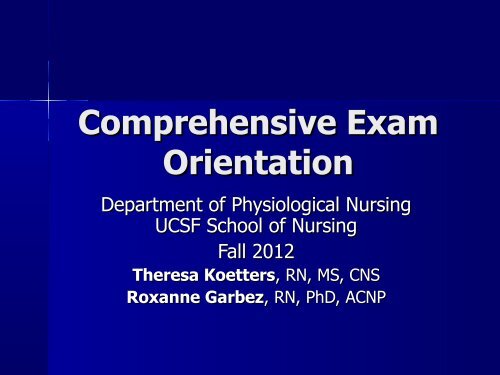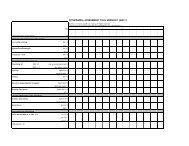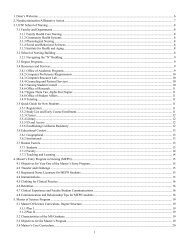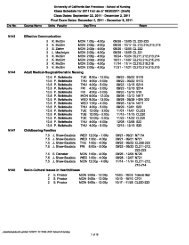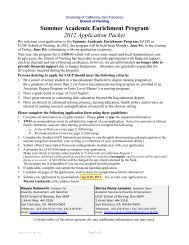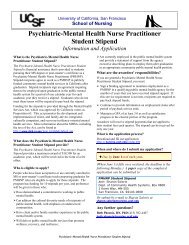Comprehensive Exam Orientation
Literature Review - UCSF School of Nursing
Literature Review - UCSF School of Nursing
Create successful ePaper yourself
Turn your PDF publications into a flip-book with our unique Google optimized e-Paper software.
<strong>Comprehensive</strong> <strong>Exam</strong><br />
<strong>Orientation</strong><br />
Department of Physiological Nursing<br />
UCSF School of Nursing<br />
Fall 2012<br />
Theresa Koetters, , RN, MS, CNS<br />
Roxanne Garbez, , RN, PhD, ACNP
Outline of Comp Process<br />
Description of the project<br />
The <strong>Comprehensive</strong> <strong>Exam</strong> Handbook<br />
Qualifying for the examination<br />
Important dates<br />
Technical requirements<br />
Resources
The Assignment<br />
The purpose of this paper is to<br />
evaluate your ability to:<br />
– Critique research as it applies to your<br />
area of specialization.<br />
– Apply advanced knowledge to clinical<br />
practice.<br />
– Apply writing skills to the dissemination of<br />
nursing information; scholarly paper<br />
– Consumer of research
Critical Points<br />
Thirty (30) page paper<br />
(maximum)<br />
Three exam options<br />
– Critical Literature Review<br />
(CLR)<br />
– Problem-solving (PS)<br />
– Research proposal
The Handbook<br />
You can download a copy<br />
of the <strong>Comprehensive</strong><br />
<strong>Exam</strong>ination Handbook<br />
from the UCSF School of<br />
Nursing website<br />
http://nursing.ucsf.edu/student-resources
How to Qualify for the<br />
<strong>Exam</strong>ination<br />
You are eligible in the last quarter you<br />
are enrolled in course and clinical<br />
work.<br />
If you have completed ALL course<br />
work with the exception of the comp<br />
exam you may submit the exam while<br />
on filing fee status for a reduced fee.
Filing Fee Status<br />
Talk with your advisor.<br />
You qualify if you have completed ALL<br />
course and clinical work. You may not take<br />
courses of any type if you are on Filing Fee<br />
status.<br />
Apply and pay filing fee to OAR<br />
Can be used for second attempt<br />
Filing fee status can be used only once. If<br />
you pay filing fee then do not submit your<br />
comp you must pay full tuition for a<br />
subsequent quarter.
Advance to<br />
Candidacy<br />
Before you can be issued your individualized<br />
Comp Number, YOU MUST ADVANCE TO<br />
CANDIDACY.<br />
Advance to Candidacy forms are available<br />
from the Office of Admissions and Registrar.<br />
Forms can also be downloaded online.<br />
After you submit your form Graduate<br />
Division notifies Office of Student Affairs.<br />
OSA will then generate your Comp Number.
The Last Quarter of<br />
Course and Clinical Work<br />
Advance to<br />
Candidacy any time<br />
before the first week<br />
of the quarter in<br />
which you plan to<br />
turn in the comp.<br />
No incompletes on<br />
record.<br />
Current in payment<br />
of fees.
Know the Important<br />
Dates- Spring 2013<br />
Number pick up date:<br />
– Between April 9 and April 22<br />
Submit comp by Noon<br />
– April 23<br />
Notification of results<br />
– May 23
Technical and Procedural<br />
Points<br />
Format<br />
Submission<br />
Scoring
Formatting Expectations<br />
APA 6th Edition format<br />
Margins 1 inch on all 4 sides of page<br />
Can separate syllables at the end of a line<br />
30 pages of text, not counting title page,<br />
reference list and appendices<br />
Title should reflect content<br />
No abstract<br />
Double-spaced, 12 point uncompressed font<br />
(Acceptable font examples:<br />
Times New Roman, Arial)
Submission Requirements<br />
One single-sided original of the<br />
comprehensive examination<br />
Three double sided copies<br />
Completed face sheet attached to each copy<br />
of the exam<br />
Separate paper with student’s name,<br />
address, home and work number, and other<br />
pertinent information that facilitates the<br />
student being contacted if necessary<br />
It is the student’s responsibility to ensure<br />
that the comprehensive exam is submitted<br />
by 12 noon on the due date
Face Sheet<br />
In order to pick up your number you<br />
must complete the face sheet and<br />
return it<br />
– List your specialty<br />
– Topic<br />
– Suggested readers<br />
ID number is given to you to be<br />
placed on your comp<br />
14
Reading and Scoring<br />
Student may select up to five preferred<br />
readers (not required)<br />
Student is not guaranteed a preferred<br />
reader<br />
Readers use a standard scoring system<br />
Student will be given the faculty<br />
comment sheets at the end but not the<br />
scoring sheets
Plagiarism<br />
Evidence of<br />
plagiarism results in<br />
a failure of the<br />
comprehensive<br />
exam.<br />
Plagiarism can<br />
become grounds for<br />
dismissal from the<br />
School of Nursing.
In Case of Failure<br />
Pass/fail<br />
discrepancy goes to<br />
a third reader.<br />
<strong>Exam</strong> fails if two<br />
readers fail it.<br />
May retake exam<br />
only once.<br />
Must submit second<br />
exam within 5<br />
quarters.
Vital Resources<br />
Vital resource—Department Administrative<br />
Assistants<br />
– CHS Kathryn Young<br />
– PN James Negri<br />
– FHCN Maria-Elena Sotelo<br />
– SBS Brandee Woleslagle<br />
<strong>Comprehensive</strong> <strong>Exam</strong> Coordinators<br />
– CHS Beth Phoenix & Dana Drew-Nord<br />
– PN Theresa Koetters & Roxanne Garbez<br />
– FHCN Karen Duderstadt & Barbara Hollinger<br />
– SBS Susan Chapman
Additional Resources<br />
Advisors- topic and<br />
format<br />
Specialty faculty<br />
Sample comps on<br />
reserve<br />
Office of Student<br />
Affairs for tutors<br />
and editors, contact<br />
Judy Martin-Holland<br />
Consider other<br />
arrangements<br />
– Typist<br />
– Paid tutors and<br />
editors<br />
– Peers as editors and<br />
proofreaders<br />
Create a timeline<br />
– See sample<br />
provided
<strong>Comprehensive</strong> <strong>Exam</strong><br />
2012-2013<br />
SEP OCT NOV DEC JAN FEB MAR APR MAY JUN JUL AUG<br />
Identifying the<br />
phenomenon of interest<br />
Topic generation<br />
Faculty input re: topic<br />
Literature review<br />
• Advance to Candidacy: Before end of Winter<br />
Quarter<br />
• Pick up Comp # from Departments: From<br />
4/09/13 to 4/22/13<br />
• Submit Comp to Departments: 4/23/13<br />
Refine topic outline<br />
Faculty input re:<br />
topic outline<br />
Advance to<br />
Candidacy<br />
Draft #1<br />
Colleagues read paper<br />
for clarity and organization<br />
Draft #2<br />
Pick up<br />
Comp #<br />
Submit<br />
Comp<br />
Edit
WORK HARD, DO WELL!<br />
Extensions,<br />
examination by mail,<br />
summer comps, oral<br />
exam are available<br />
only by special<br />
arrangement. Read<br />
the corresponding<br />
section of the comp<br />
handbook.
Part 2<br />
22
Sample <strong>Exam</strong>inations<br />
On reserve in each of the departments<br />
Ask your advisor and/or your<br />
department's comprehensive<br />
examination coordinator<br />
23
Other Resources<br />
UCSF SON website<br />
24
Choosing a Theory<br />
A theory should further clarify or<br />
explain your topic<br />
Nursing theory not required<br />
Explain your theory in the text—don’t<br />
depend on diagrams in the appendix<br />
25
Theory or Conceptual<br />
Framework<br />
A theory is a structure that enables<br />
you to explain a phenomenon. There<br />
is no right or wrong theory--it is all in<br />
how you want the argument you want<br />
to make.<br />
26
Possible Mechanisms Underlying the<br />
Increased Risk of Type 2 Diabetes in<br />
People on Atypical Psychotrophics<br />
Physiological<br />
Genetics<br />
Co-moridity<br />
Sociocultural<br />
Health care<br />
Behavioral<br />
Medication<br />
HPA axis and sympathetic nervous system hyperactivity<br />
resulting in overproduction of cortisol.<br />
Diabetes only occurs in those with a genetic<br />
predisposition.<br />
The diabetes is really due to alcoholism or binge eating.<br />
Due to socioeconomic, disability, marital status, access<br />
to health care<br />
Providers fail to adequately monitor overall health.<br />
Inactivity, diet, smoking due to the psychiatric illness<br />
side effects, appetite stimulation and subsequent weight<br />
gain<br />
27
Possible Titles<br />
The Relationship Between Atypical<br />
Psychotropic Use and Diabetes<br />
Mellitus: The role of Genetics<br />
Sociocultural Factors in the<br />
Development of Diabetes Mellitus in<br />
Patients with Severe Mental Illness<br />
28
Types of <strong>Exam</strong>inations<br />
Research Proposal (check with your<br />
advisor as early as possible)<br />
Problem-solving<br />
Critical Literature Review<br />
29
Research Proposal<br />
To evaluate a student’s ability to<br />
identify a significant research question<br />
relevant to nursing practice, and to<br />
design a methodology for addressing<br />
the question.<br />
Study does not have to be carried out<br />
Must have access to UCSF faculty with<br />
research experience to mentor you<br />
30
Research Proposal<br />
Good choice if you plan to build on<br />
this topic for future research or<br />
doctoral work<br />
Could be taken back to your workplace<br />
for implementation if approval given<br />
by institution
Research Proposal<br />
Scoring<br />
Total Points – 330<br />
– Area 1 – Study and Context – 63<br />
– Conceptual Framework and Literature<br />
Review - 126<br />
– Methodology – 126<br />
– Technical (grammar, organization, use of<br />
APA format) – 15
The <strong>Comprehensive</strong> <strong>Exam</strong><br />
is Pass/Fail<br />
Points needed to pass - 231
Problem-solving<br />
<strong>Exam</strong>ination<br />
Purpose: : To evaluate the student’s<br />
ability to effectively communicate the<br />
resolution of a problem in an area of<br />
specialization.<br />
Describes an identified need stemming<br />
from a discrepancy between what is or<br />
what could/should be.<br />
34
Choosing a Problem-solving<br />
Topic<br />
Can be a problem on<br />
an individual or a<br />
systems level.<br />
Must be appropriate<br />
to the clinical<br />
situation<br />
– Think of a situation<br />
that is challenging to<br />
you<br />
Must be feasible!<br />
Must be measurable!<br />
35
<strong>Exam</strong>ples of Problem-Solving<br />
Topics<br />
Initiating an Oral Care Program in a<br />
Nursing Home<br />
Post-Partum Depression: Transition to<br />
Motherhood<br />
ICU Nurses’ Knowledge Deficit<br />
Regarding Hemodynamic Monitoring<br />
Loss of Venous Access and Dialysis<br />
Delay in End Stage Renal Disease<br />
Patients<br />
36
Problem-solving Cautions<br />
Instituting a delirium treatment program in<br />
acute care setting<br />
– Is delirium identified? Multiple etiologies…what<br />
will the intervention be? How will you measure<br />
this?<br />
Improving parenting skills by identifying<br />
temperament in toddlers in preschools<br />
– What is meant by “parenting skills?” How will you<br />
get access to preschools? Is there literature that<br />
indicates that identifying temperament will change<br />
parenting behavior?<br />
37
The Problem and its<br />
Environmental Context<br />
Clarity of the Problem<br />
Significance of the Problem<br />
Clarity of Setting<br />
Clarity of Roles and inter-relationships<br />
38
The Problem and its<br />
Environmental Context<br />
Clarity of the Problem<br />
– Who is solving the problem<br />
APN<br />
– Where the problem occurs<br />
ICU<br />
– What is to be accomplished<br />
Improve Nurses’ Knowledge<br />
– Target population<br />
ICU Nurses<br />
39
The Problem and its<br />
Environmental Context<br />
Significance of the Problem<br />
– Importance of the problem to patients or<br />
profession<br />
– Accurate Hemodynamic Monitoring is<br />
essential for ICU patients<br />
40
The Problem and its<br />
Environmental Context<br />
Clarity of the Setting<br />
– Home, hospital, nursing home<br />
– Intensive Care Unit<br />
41
The Problem and its<br />
Environmental Context<br />
Clarity of Roles & Inter-relationships<br />
– Describes functions of individuals sig to<br />
problem, their roles and influence on the<br />
setting<br />
– ICU nurses, Clinical Nurse Specialist,<br />
Head Nurse<br />
42
Literature Review<br />
Quality of references<br />
Addresses elements of critique<br />
Quality of critique and interpretation<br />
Quality of theoretical discussion
Intervention, Implementation<br />
& Evaluation<br />
Expected Outcomes<br />
Defensibility<br />
Realism<br />
Clarity & Appropriateness of<br />
Intervention Implementation<br />
Clarity & Appropriateness of Evaluation<br />
Procedure<br />
44
Intervention, Implementation<br />
& Evaluation<br />
Clarity of Expected Outcomes<br />
– Improvement of Nurses Knowledge<br />
evidenced by improvement on post-test<br />
scores<br />
45
Intervention, Implementation<br />
& Evaluation<br />
Clarity & Appropriateness of<br />
Implementation<br />
– Outline procedures for implementing the<br />
intervention and ensuring they are<br />
appropriate<br />
– Educational intervention was three-fold<br />
Self-study, then 4 hour mandatory class,<br />
bedside guides developed<br />
46
Intervention, Implementation<br />
& Evaluation<br />
Clarity & Appropriateness of Evaluation<br />
Procedure<br />
Delineates specific measurable and<br />
appropriate evaluation criteria<br />
– Pretest and post-test measure of ICU<br />
nurses’ knowledge is measured<br />
– Number of incident reports are analyzed<br />
regarding monitoring<br />
47
Intervention, Implementation<br />
& Evaluation<br />
Defensibility<br />
– Demonstrates intervention has potential<br />
for substantial improvement in the<br />
problem<br />
Realism<br />
– Feasibility of intervention<br />
– Will an educational intervention be<br />
possible?<br />
48
Technical Criteria<br />
Grammar and spelling<br />
Organization of paper<br />
APA format<br />
49
Caveats<br />
Must have a feasible, effective and<br />
defensible evaluation method<br />
Do not wait until the end to decide on<br />
method of evaluation<br />
When writing, do not always start with<br />
the beginning of the paper and<br />
progress to the end or your evaluation<br />
will suffer.<br />
50
Problem-solving Scoring<br />
Total Points - 330<br />
– Area 1 – The Problem - 105<br />
– Area 2 – Literature Review - 105<br />
– Area 3 – Intervention, Implementation,<br />
Evaluation - 105<br />
– Area 4 – Technical (grammar,<br />
organization, APA) - -15<br />
EACH SECTION IS EQUALLY WEIGHTED SO<br />
PLAN FOR 10 PAGES PER SECTION!<br />
51
Critical Literature Review<br />
Choosing a Topic<br />
Pose a question<br />
Do initial searching<br />
There is enough research, but no<br />
synthesis of findings or clear direction<br />
You want to argue a point that has<br />
some evidence, but is not established<br />
practice<br />
52
Critical Literature Review<br />
Topic or Issue<br />
Clarity of topic or purpose<br />
State in 1 sentence!<br />
The purpose of this paper is to<br />
examine the literature related to the<br />
diagnosis of BNP in heart failure<br />
53
Topic or Issue<br />
Significance of topic<br />
4.8 million in US have HF, 50% are<br />
rehospitalized in 6 mos., there is no<br />
lab test for diagnosing HF, BNP might<br />
provide better method for evaluation<br />
of SOB than symptoms<br />
54
Literature Review –<br />
<strong>Exam</strong>ples<br />
Evaluating cognitive function after<br />
stroke<br />
Family presence during resuscitation<br />
HRT in perimenopausal women<br />
BNP levels in the diagnosis of heart<br />
failure<br />
Evaluation of depression in<br />
adolescence<br />
55
Some evidence exists, but<br />
practice is not well delineated<br />
<br />
<br />
Should diabetics use<br />
ACE inhibitors to<br />
prevent renal<br />
impairment ?<br />
This is well-established<br />
by scientific study and<br />
standard of practice in<br />
most settings.<br />
<br />
<br />
Is it safe to give people<br />
with stage 4 kidney<br />
disease ACE inhibitors<br />
to prevent<br />
progression?<br />
Practitioners have been<br />
hesitant to give people<br />
with stage 4 CKD ACE<br />
inhibitors for fear of<br />
increasing creatinine or<br />
potassium to<br />
dangerous levels.<br />
56
Literature Review<br />
Quality of References<br />
Elements of Critique<br />
Quality of Critique<br />
Theoretical Discussion<br />
57
Literature Review<br />
Quality of References<br />
– References significant to the problem<br />
area – classic & current while noting gaps<br />
in research literature if any<br />
58
Literature Review<br />
Organization of review<br />
Rationale for selected articles, describe how<br />
organized<br />
How many articles should you critique?<br />
These journal articles were chosen because<br />
they include…….and the oldest is reviewed<br />
first….<br />
Quality of references – key classic and<br />
current literature<br />
59
Literature Review<br />
Elements & Quality of Critique –<br />
Articulate Main Points<br />
– Sample<br />
– Design<br />
– Procedure<br />
– Measures<br />
– Results<br />
– Conclusions<br />
60
Literature Review<br />
Theoretical Discussion<br />
Must address the foundation of your<br />
question or problem<br />
– <strong>Exam</strong>ple: Sepsis and EGDT<br />
Use Physiologic theory to explain why EGDT is<br />
appropriate for septic patients<br />
Use Change Theory if you want to implement<br />
EGDT in a new setting that manages septic<br />
patients<br />
61
Literature Review Critique<br />
Quality of Theoretical discussion<br />
Theoretical approach to the topic<br />
62
Literature Review Critique<br />
Addresses elements of critique<br />
– Sample<br />
– Design<br />
– Procedure<br />
– Measures<br />
– Results<br />
– Conclusions<br />
63
Literature Review Critique<br />
Quality of critique and interpretation<br />
YOUR ASSESSMENT OF THE STUDIES<br />
Too small of a sample size to give<br />
power to find a difference between<br />
those with and without HF, authors<br />
were biased b/c they knew the BNP<br />
level and may have changed<br />
treatment, only generalizable to men…<br />
64
Make a Table!<br />
Organize your literature into a table to<br />
compare and contrast<br />
Describe each study<br />
65
Literature Review<br />
Discussion and Application<br />
Critical and original analysis<br />
Integration and synthesis of<br />
research articles<br />
Implications for practice<br />
Future research<br />
66
Discussion and Application –<br />
Where students get stuck!<br />
Critical and original analysis<br />
Final summary of the literature<br />
67
Identifies gaps in literature,<br />
implications for practice, need for<br />
further research<br />
STICK your neck out there! Make your<br />
opinion known, however you must<br />
base it on the critique of the literature<br />
you presented rather than your<br />
opinion.<br />
68
Literature Review Scoring<br />
Total Points - 330<br />
– Area 1 – Topic or Issue - 70<br />
– Area 2 – Literature Review - 165<br />
– Area 3 – Discussion & Application - 80<br />
– Area 4 – Technical (grammar,<br />
organization, APA) 15<br />
LITERATURE REVIEW 50% OF THE PAPER<br />
69
Most common reasons why<br />
comps fail<br />
Started too late to put in necessary time<br />
and effort<br />
Did not meet with advisor to make sure you<br />
are on track<br />
Did not follow the advice of your advisor<br />
Primary editor was someone whose english<br />
composition skills were not adequate to give<br />
you appropriate feedback on your writing
I PASSED!<br />
71


